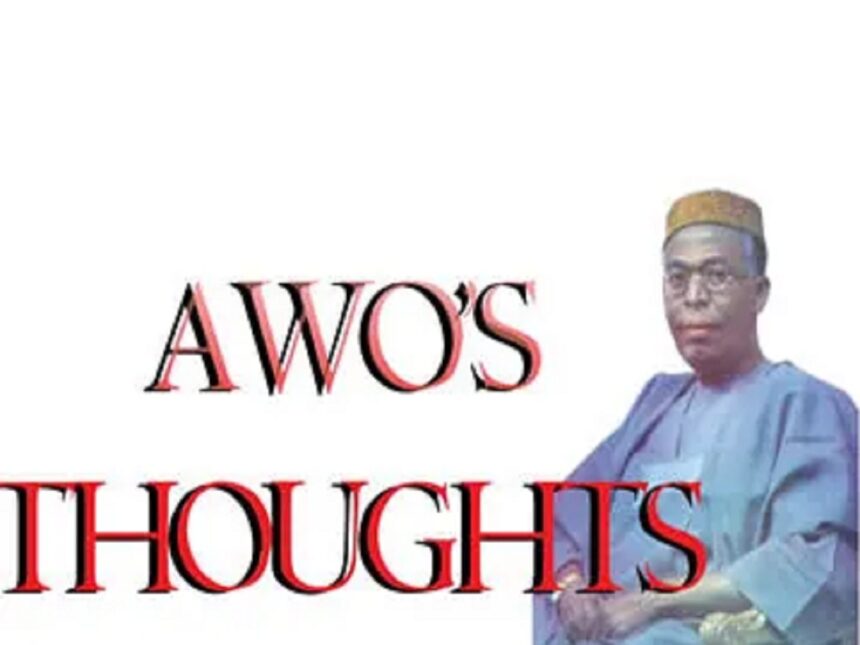A Call for Free Education and Free Healthcare Delivery for ALL Nigerians as contained in the University of Ife Convocation Speech by Chief Obafemi Awolowo on Saturday, 6th July, 1974.
CONTINUED FROM LAST WEEK
1973 PROVISIONAL CENSUS RESULT
From the time it was first conducted in 1931, census enumeration in Nigeria has consistently produced disputable result.
The 1931 enumeration made no pretense at all to comprehensive count or accuracy. At best, the whole exercise was an intelligent guesstimate, insofar as the southern part of the country was concerned.
In Economic Survey of Nigeria 1959, published under the direction of Nigeria’s National Economic Council, the following comment is made at page 103:
‘… The 1931 census figures for southern Nigeria, apart from Lagos, were rarely more than an estimate of population based on the number of males assessed for tax …‘
Having regard to the hostility of the people of the South to taxation (vide Adubi Rising of 1918 and Aba Riot of 1930), and the widespread tax evasion prevalent in that part of the country, it is not difficult to come to the conclusion that, for the South at least, the 1931 census erred on the side of gross underestimation.
There are good grounds for the view that the 1952/53 census figures represent an equally gross underestimation for the whole country.
In the first place, the siting of schools in the Western Region in 1953 and 1954 revealed that a large number of villages had been omitted from the count. These omissions were further confirmed by the huge excess of the number of children actually registered in 1954 over the estimated number based on the census figures of 1952.
In the second place, according to the Western Region of Nigeria Statistical Abstract, the estimated population of the Western State in 1951, at 2 percent growth rate, based on the 1931 underestimation is 4.505 million. But the 1952 enumeration yielded a figure of 4.35 million for the Western State. An estimate based on the 1931 figure at 2 percent growth rate, would have yielded 4.6 million for the Western State in 1952 as against 4.35 million.
In the third place, an estimate based on Unesco’s Statistical Yearbook’s estimated population figure for Nigeria for 1950 should give us an estimated population of 37.047 million in 1953. But the actual enumeration gave us 30.417 million, which is 6.630 million less than UNESCO’s estimate at 2.5 percent growth rate.
The 1962 census result was rejected; and so, we do not need to dwell upon it, except to take note of it as another instance of the ungracious career of census enumeration in Nigeria.
In 1963, however, we had another headcount which gave Nigeria a population of 55.670 million.
The U.N. Statistical Yearbook 1971 gives the midyear estimate for 1963 as 46.324 million which is 9.346 million less than the 1963 census result.
This YEARBOOK has the following footnote on page 72 on Nigeria’s census figure for 1963:
‘There is a possibility that the 1963 census overstated the population. The size of this possible overstatement may be judged from the midyear estimates for 1963 and 1970 provided by the United Nations’ Population Division.’
I will be the last person to dismiss independent estimates made by the United Nations’ Population Division out of hand.
But after a careful study of all the available data and information on the subject, I have come to the conclusion that, of all the ugly and disputable census results with which Nigeria has had the misfortune to be afflicted from 1931 to 1973, the LEAST UGLY or, if you like, the LEAST DISPUTABLE OF THEM ALL IS THE 1963 CENSUS RESULT.
The reasons are not far to seek.
Firstly, as has been pointed out, the figures for 1931 and 1953 suffer from gross underestimation. That being so, the growth rate of 5.6 percent indicated between 1953 and 1963 should be taken as containing compensatory elements for the excessive errors and omissions of 1931 and 1953.
Secondly, in one of the footnotes, the U.N. Statistical Yearbook 1971 states that its estimate of 46.324 million for 1963, which is printed in italics on page 64, is of ‘QUESTIONABLE RELIABILITY’.
Thirdly, in Africa South of the Sahara 1974 (a Europa Publication), at page 587, Professor Ojetunji Aboyade and Miss Jane Carroll, after making reference to the figure of between 41.5 million and 45 million at which independent estimates put our population in 1963, comment on our current population figure, as projected by the Federal Office of Statistics, as follows:
‘HOWEVER, IN THE LIGHT OF RECENT INDIRECT EVIDENCE (e.g. STATISTICAL FIELD RETURNS Of THE MASS VACCINATION CAMPAIGN) THE CURRENT OFFICIAL FIGURE OF TOTAL POPULATION MAY WELL BE NEAREST THE TRUTH THUS INDICATING GROSS UNDERCOUNTING FOR 1931 AND 1952/53 CENSUSES.’
This brings me to the 1973 census result.
I have examined this result from several standpoints which time does not permit me to elaborate upon here, and as a result, I have been irresistibly impelled to the conclusion that the so-called PROVISIONAL FIGURES are absolutely unreliable and should be totally rejected by the Supreme Military Council.
In the first place, based on UNESCO’s estimate in its Statistical Yearbook 1972, at 2.5 percent growth rate, our estimated population for 1973 should be 59.63 million. The 79.76 million population, which we are now trying to bestow upon ourselves, is, therefore, 20.40 million more than the estimate based on the UNESCO projection. By comparison, the U.N. and UNESCO estimates gave us 46.324 million in 1963 as against 55.670 million. In 1963, therefore, we exceeded the UNESCO estimate only by 9.34 million; whereas in 1973, we exceeded the U.N. and UNESCO estimate by 20.40 million.
CONTINUES NEXT WEEK
READ ALSO: Learning from past censuses
WATCH TOP VIDEOS FROM NIGERIAN TRIBUNE TV
- Let’s Talk About SELF-AWARENESS
- Is Your Confidence Mistaken for Pride? Let’s talk about it
- Is Etiquette About Perfection…Or Just Not Being Rude?
- Top Psychologist Reveal 3 Signs You’re Struggling With Imposter Syndrome
- Do You Pick Up Work-Related Calls at Midnight or Never? Let’s Talk About Boundaries







